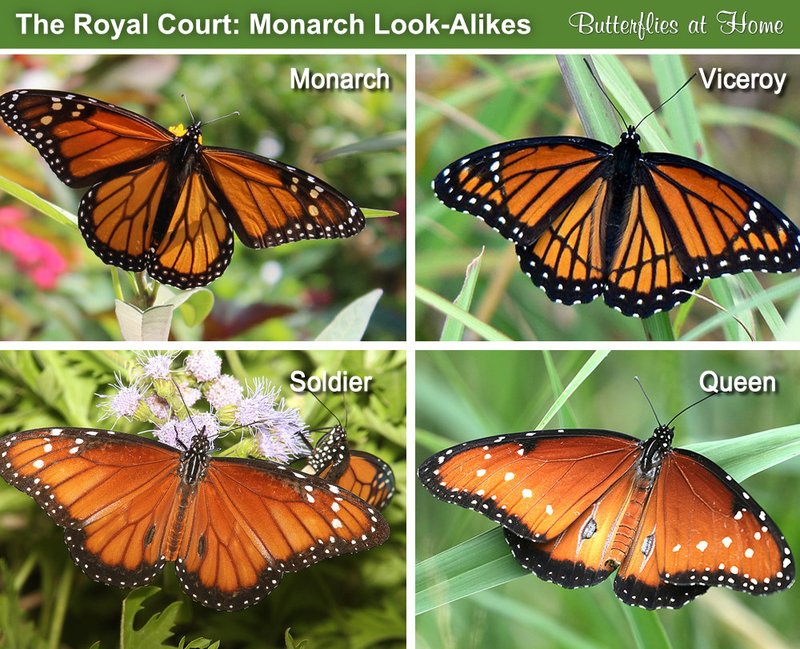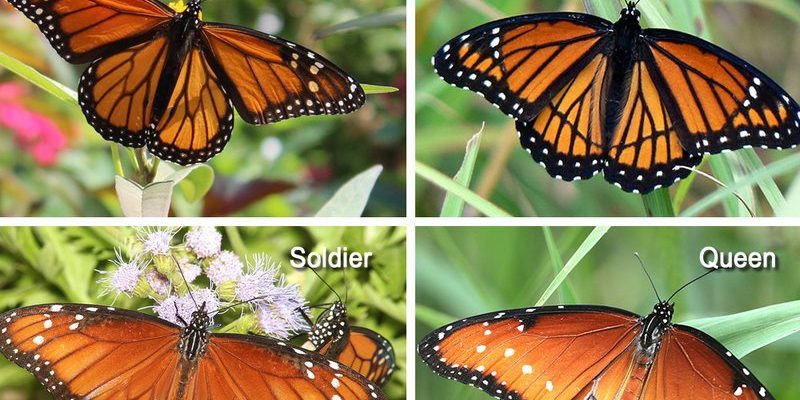
Think of the Monarch butterfly as the “rock star” of the butterfly world. It’s not just about looks, though; this butterfly also has an incredible migration story, covering thousands of miles each year. Now, it’s essential to know that not all butterflies are alike. While Monarchs stand out, other insects, like the Swallowtail and the Viceroy, share certain traits with them. By exploring these similarities and differences, you might find yourself more aware of and connected to these delicate creatures that bring color to our gardens and natural spaces.
What Makes Monarch Butterflies Unique?
Monarch butterflies are famous for their vibrant orange and black coloration, which serves as both a warning to predators and a signal of their toxic nature. Interestingly, they gain this toxicity from the milkweed plants that caterpillars feed on during their larval stage. This connection between the Monarch and its diet showcases the interdependence in nature. Honestly, it’s fascinating how what they eat influences their survival and their role in the ecosystem.
When Monarchs go through metamorphosis, they undergo a transformation that is nothing short of miraculous. From the tiny egg to the hungry caterpillar (often called a larva), to the chrysalis, and finally to the stunning adult butterfly, the journey takes about 10 days to two weeks. Each stage is crucial, and they face many challenges, including predators, weather, and human activity. You might be wondering how this compares to other butterflies.
Monarch Butterfly Migration: A Journey Like No Other
One of the most incredible aspects of Monarch butterflies is their migration. Every year, they travel up to 3,000 miles from North America to central Mexico. Imagine embarking on such a long journey with no GPS or roadmap! Monarchs follow a combination of environmental cues, like sunlight and the position of the sun, to guide them. This journey is not just a simple stroll; it’s hazardous and requires immense energy.
During migration, Monarchs often fly in large groups, forming beautiful clouds of color in the sky. When they reach their wintering grounds in Mexico, they cluster together in massive numbers, covering entire trees. It’s a sight that can take your breath away. This migration is vital for their reproduction cycles, as they take the opportunity to mate and lay eggs in the spring when they return north.
Similar Insects: The Viceroy Butterfly
Now, let’s talk about the Viceroy butterfly. At first glance, you might mistake it for a Monarch because of its similar appearance. However, there are some key differences. Viceroys have a horizontal black stripe across their hindwings, which distinguishes them from their lookalike cousins. This stripe is more than just a fashion statement; it’s a clever trick to deter predators. By looking like a Monarch, Viceroys gain some protection, as predators have learned to avoid the toxic Monarchs.
The Viceroy also has a preference for different habitats. While Monarchs often thrive in open fields and meadows, Viceroys are usually found near water bodies, such as ponds and marshes. They also feed on various plants, not just milkweed. This adaptability is crucial for their survival, especially in changing environments. You can see how different species develop unique strategies to thrive, even when they look similar.
Comparing the Swallowtail Butterfly
Another interesting insect is the Swallowtail butterfly. Unlike the Monarch, Swallowtails come in various colors and sizes, but they often have the distinctive forked tail on their hindwings, resembling a swallow. This feature, along with their large size, sets them apart and makes them easy to identify. They, too, are quite striking with bold colors that can range from yellow and blue to black, depending on the species.
Swallowtails are known for their incredible diversity; there are about 550 different species around the world. They’re also skilled at adapting to different environments. Just like Monarchs, Swallowtails undergo a metamorphosis, but their caterpillars often have unique defensive mechanisms, like mimicking bird droppings or having eye spots to scare off predators. This adaptability helps them survive in various habitats, from gardens to woodland areas.
Butterflies vs. Moths: What’s the Difference?
You might be wondering how butterflies like Monarchs and Viceroys compare to moths, which often get overshadowed by their more colorful cousins. The key differences lie in their behavior and physical traits. Butterflies are usually active during the day, whereas most moths are nocturnal. Think of butterflies as the extroverts of the insect world, flaunting their colors in the sunlight, while moths prefer a more reserved, nighttime existence.
Another distinction is in their antennae: butterfly antennae are slender and club-shaped, while moth antennae can be feathery or threadlike. Moths also tend to have thicker bodies and can vary in color, often being duller than butterflies. While Monarchs and their similar counterparts are celebrated for their beauty, many moths showcase their charm in subtler ways. For instance, the Luna moth is pale green and has long tails on its hindwings, making it an enchanting sight at night.
The Importance of Butterflies and Similar Insects
So why should we care about Monarchs and their similar insects? Butterflies are not just beautiful; they play crucial roles in our ecosystems. They are essential pollinators, helping plants reproduce by transferring pollen between flowers. This process is vital for fruit and vegetable production, impacting our food supply and the health of our environment.
Furthermore, studying these insects can give scientists valuable insights into environmental changes. The Monarch butterfly, in particular, is sensitive to climate variations, making them a kind of indicator species. By monitoring their populations and migration patterns, scientists can assess the impact of climate change and habitat loss. Protecting Monarchs and similar species supports biodiversity and helps maintain the balance of our natural world.
Conservation Efforts: Protecting the Monarch Butterfly
As charming as they are, Monarch butterflies face numerous threats, including habitat loss and pesticide use. To help protect them, many conservation efforts focus on creating butterfly gardens filled with native plants, especially milkweed. These gardens provide safe spaces for Monarchs to feed, lay eggs, and thrive.
You can get involved, too! Planting native flowers in your yard or community spaces supports these beautiful insects. You can also advocate for pesticide-free gardening practices. Every little action counts, and by raising awareness, we can help ensure that future generations can enjoy the sight of Monarchs fluttering through the air.
In conclusion, comparing the Monarch butterfly to similar insects like the Viceroy and the Swallowtail highlights the rich tapestry of the insect world. Each species has its unique traits, behaviors, and importance, contributing to the overall health of our environment. So next time you spot a Monarch soaring by, take a moment to appreciate all its neighbors in the butterfly family. Happy observing!

